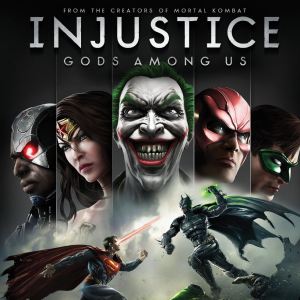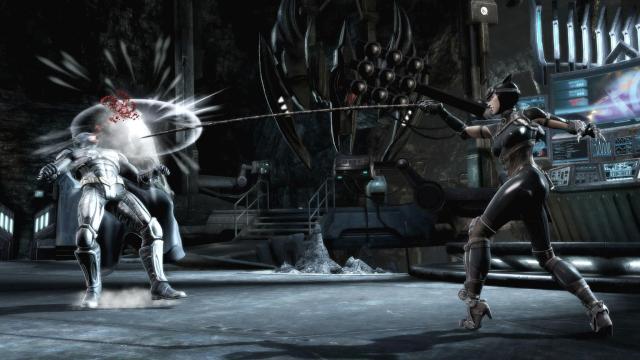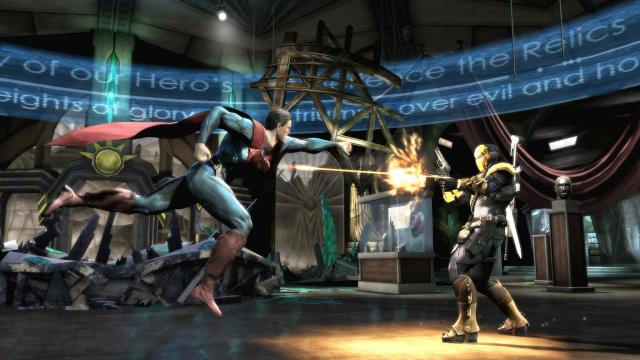
As Harold McMillan once said, fighting game fans have never had it so good. Well that wasn’t quite what he said, but if he had, he would have been absolutely right. There are currently more fighting games available than at any point since the boom of the early ’90s, and the difference is that this time, the vast majority of them are pretty brilliant. From remastered classics like Third Strike and Guilty Gear, to modern instalments of established franchises like King of Fighters, Tekken and MvC , to exciting new titles like Skullgirls and Blazblue, the genre has seen one quality release after another since the launch of Street Fighter 4 in early 2009. There have been occasional misadventures though, and worryingly, the highest profile of these was probably Warner Bros’ Mortal Kombat vs DC Universe. It wasn’t a bad game as such, but mismatched battles (Superman vs Sonya Blade?), the toning down of the Mortal Kombat gore factor to fit in the DC characters and the general clunkiness of the gameplay meant that nobody really came away a winner. Which brings us onto Injustice, a DC Universe based fighting game from the creators of Mortal Kombat. Will it redeem the DC name among fighting game fans, or will it confirm the company as the black sheep of family?
Well, for a start, most worries have been put firmly to one side by 2011’s Mortal Kombat reboot. It was easily the best game in the long-running series and Injustice is built upon the same foundations as NetherRealm’s previous title. That’s not to say that it’s just Mortal Kombat with super heroes though, as there are some pretty fundamental differences that make Injustice a unique fighting game in its own right. Firstly, there’s no block button, with players now using the time-honoured tradition of holding back to soak up attacks. Players like myself who play a range of fighting games will no doubt welcome this move as blocking with a button is an annoyingly difficult habit to get into. In fact, the general button layout is radically different to most fighting games, and takes a little bit of thinking about, especially if you’re trying to configure a fight stick. Alongside your standard Light, Medium and Heavy attack buttons, you now have a Character Power button that produces a unique attack or ability for each character, a Meter Burn button that can allow players to enhance their special moves, and a Flip Stance button that doesn’t do a whole bunch on its own but is needed in collaboration with other buttons for other purposes. It’s nothing particularly complicated, but as throwing, stage interactions, tech rolling and super moves all need a combination of these buttons, some consideration is needed to avoid complicated finger positions and painful hand cramps. The game itself initially feels quite similar to Mortal Kombat, with moves linking together and being performed in a familiar way. But the more you play, the more different the game begins to feel. It feels less rigid than its bloody cousin, and you get the impression that there is an extra layer of depth here that may take some time to mine. I was surprised at how unique the game felt and it’s safe to say there really isn’t another game that feels or plays like Injustice does.

The roster draws from a wide range of DC franchises, with most of the obvious protagonists being present and correct. There is a slight over reliance on the Batman series, but there should be enough mainstream characters (Batman, Superman, Wonder Woman etc) and more less known ones (Raven, Killer Frost, Lobo etc) to please casual and hardcore DC fans alike. DLC characters have already started being launched and it will be interesting to see how far and wide they’re willing to look for extra options. The thought of DC imprints like Vertigo being used to include the likes of V or Sandman is rather too exciting to think about. Everyone is pretty well presented, and there is a wide range of alternative costumes to unlock or buy that cover different iterations of each character. Similarly, the backgrounds are varied and recognisable, although again, gloomy Gotham gets rather more coverage than other places. One major selling point here is how much interaction the stages provide, from bouncing your opponent off passing helicopters, to pounding them through walls to receiving a trippy beating from the Arkham Asylum version of Scarecrow. Interactable stages are an interesting and initially entertaining way of making no two games the same, even when playing the same player with the same character over and over, although some of the longer transition cutscenes (when a character gets smacked from one stage to another) can start to get a little tiresome after several viewings. Injustice is certainly a very good looking game , but a little more light to go with the shade would certainly help change things up a bit. If Mortal Kombat taught us anything, other than there’s more than one way to skin a ninja, it’s that NetherRealm know how to use sound to fully enhance what you’re looking at, and they’ve gone to town again here. The music is suitably epic, smashed bricks stay thoroughly smashed, and if you crank up the volume you could almost feel the thwack of fist on spandex.
Injustice has an excellent range of modes that will please both on-line heroes and single player loners alike. The story mode is both totally absurd and absolutely brilliant. Following MK’s lead, we’re taken through a narrative that involves all the heroes and villains from the game, and gives us a brief glimpse of their role and perspective of the story. It’s long, its thorough, its genuinely entertaining and I can’t think of any fighting game story mode that even comes close to how good it is. Battle Mode is basically a regular arcade play through, but allows you to unlock new circumstances to play through as you go. Training mode is simple but effective, and the S.T.A.R. Labs section allows you to play through over 200 character-specific challenges of different difficulties. Online modes again echo Mortal Kombat quite closely, with Ranked and Player matches being joined again by the excellent King of the Hill Mode which allows 8 players to watch and interact with matches whilst they wait their turn. Online play feels somewhat better than Mortal Kombat’s did, although it still doesn’t feel as solid as some of the more recent fighting game releases have. I may have been unlucky, buts it also taken me a while to find online opponents so it’s good there so many offline options to keep me playing.

So has Injustice done enough to keep its head above the increasingly deep fighting game water-line? The answer is a resounding “YES”. It would have been easy for NetherRealm to re-release Mortal Kombat, swapping Sub-Zero for Superman and Outworld for Metropolis, and it would still have sold loads and been a good game. But rather than do that, they have altered and elevated a winning formula into something bigger, better, and perhaps more importantly, different. It’s not perfect, and its unlikely to challenge the Street Fighters, King of Fighters, and BlazBlues of the world in terms of pure depth and balance. But that isn’t what Injustice is about, and the fact that it’s managed to find a unique space of its own in such a tightly packed genre is an achievement in itself. It’s big, loud, ridiculous and clever, and has finally provided DC with a serious rival for Marvel’s established fighting game franchise. DC vs Mortal Kombat 2 seems like an exceedingly good idea all of a sudden…
Reviewed on PS3


Leave a Reply